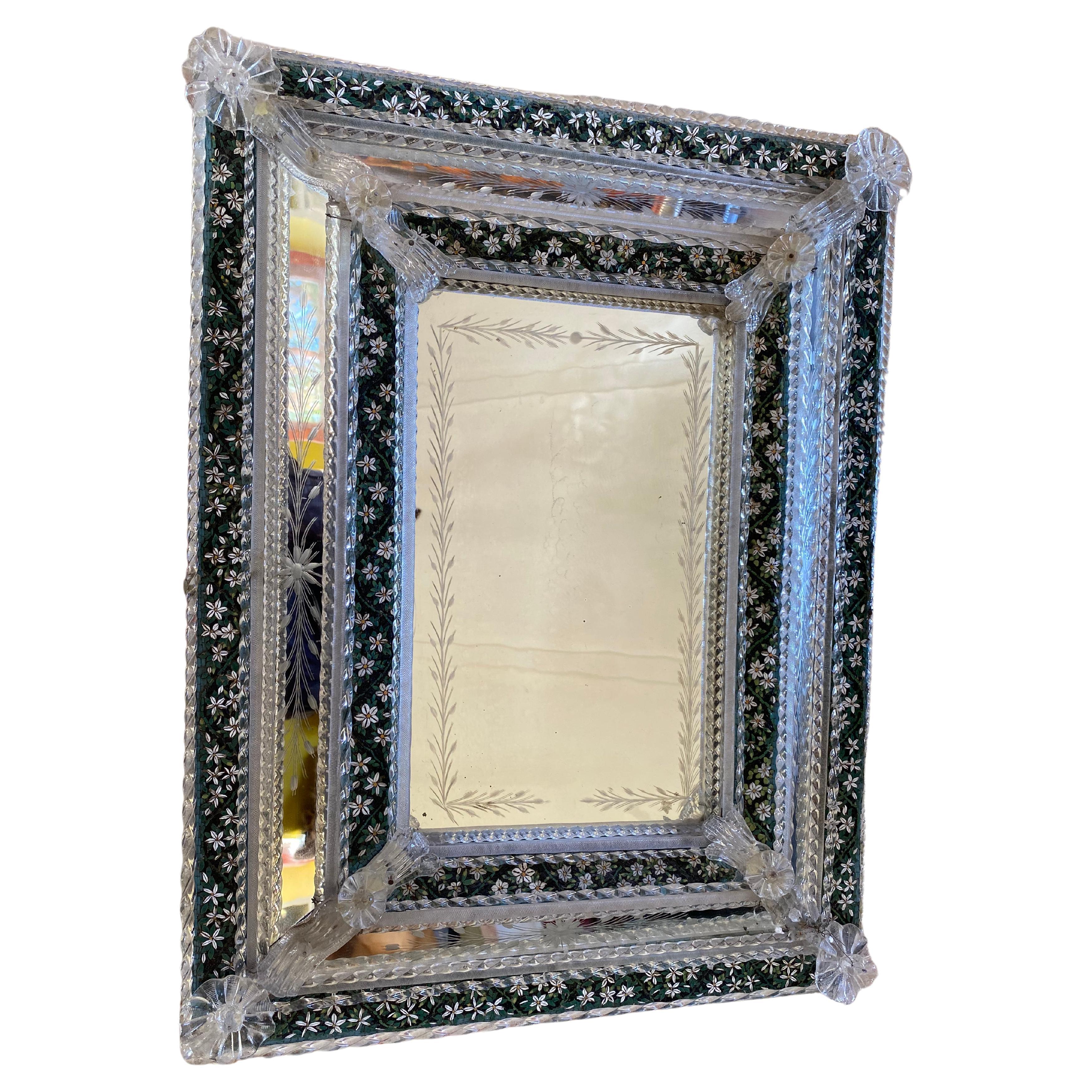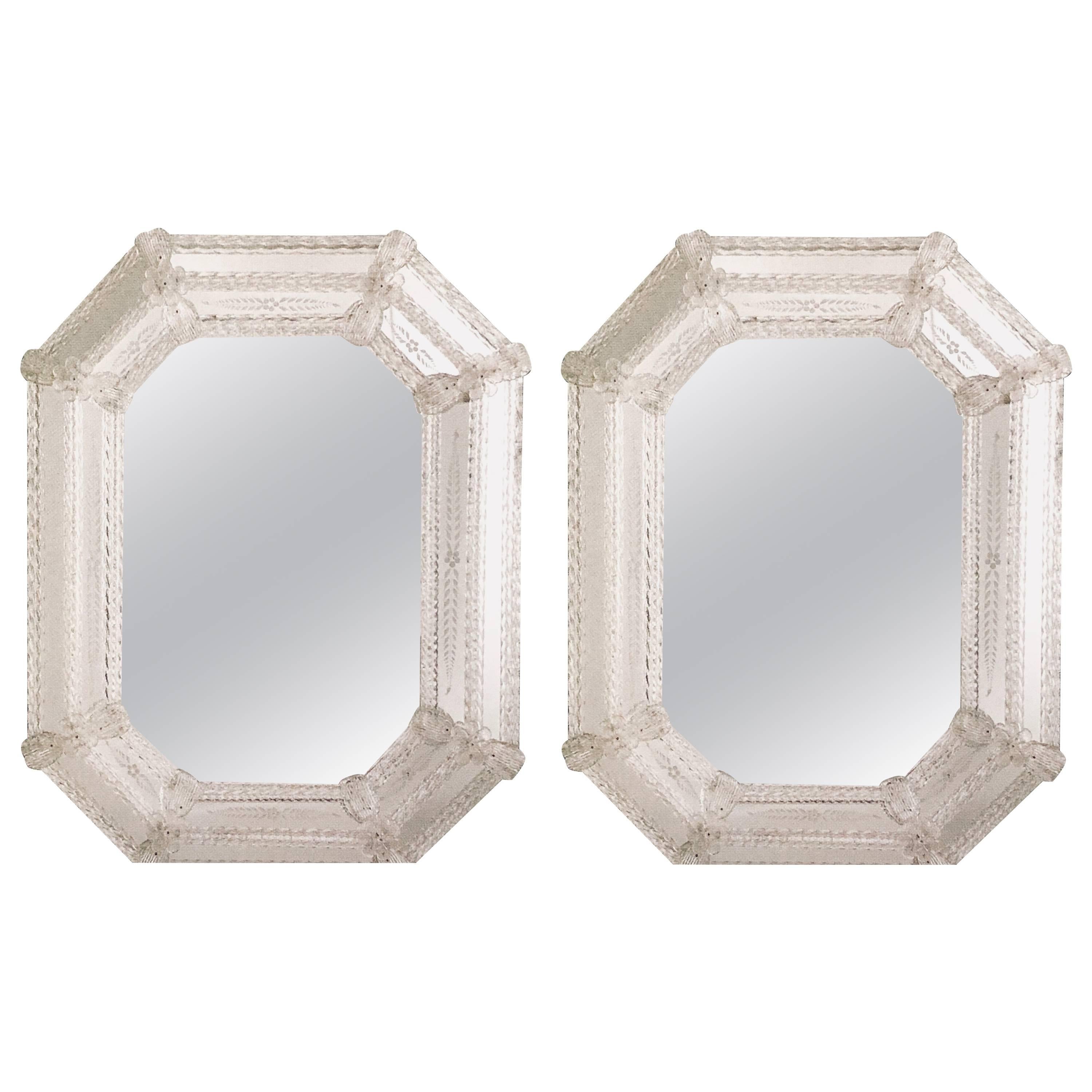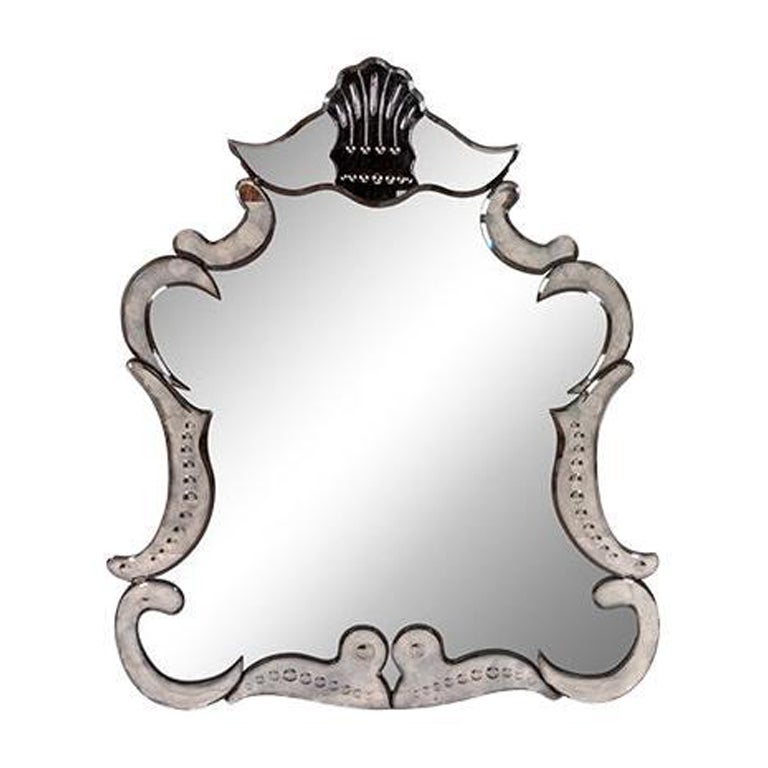Items Similar to Rare octagonal Venetian mirror in etched glass and micro-mosaic, Circa 1865
Want more images or videos?
Request additional images or videos from the seller
1 of 8
Rare octagonal Venetian mirror in etched glass and micro-mosaic, Circa 1865
About the Item
Rare octagonal Venetian mirror in etched glass and micro-mosaic, Exposition Universelle de 1867, Venice, Italy, circa 1865. Decorated with micro-mosaic cartouches featuring flowers, straw roses and foliage in light relief on a gold smaltis background, and mirror cartouches engraved with floral motifs. Each cartouche is surrounded by fine twisted glass rods, separated by glass flowers. The technique employed is of extraordinary virtuosity. This mirror was made in Venice, Italy, around 1865, at a time when Italian micro-mosaics were renowned throughout Europe.
Glassworks and mosaics of Venice - Expo Paris 1867:
Venice and Italy have just won a great success at the Universal Exhibition. The revival of one of her most famous industries is being consecrated at this very moment by the gold medal which the jury is awarding to M. Salviati, and the crowds which are crowding the halls of the Italian Exhibition in front of the great mosaics hung along the walls. Salviati, and the crowds that crowd the halls of the Italian Exposition in front of the great mosaics hung along the walls, and that surround the showcases containing these glasses so transparent and light that they look like woven, impregnated air, when their elegant forms are iridescent with those changing reflections with which the caprice of the creative artist sometimes reveals them, with a ray of the sun of beautiful and radiant Venice, - had ratified in advance the reward given to his intelligent efforts and his devotion. During the last few years, Mr. Salviati has indeed succeeded, after several unsuccessful attempts, in reviving in all its splendour that illustrious industry which the Serenissima Republic called the apple of its eye (pupilla delli occhi miei), and in favour of which, suspending the aristocratic privileges of which it was the guardian so jealous that the children of a nobleman with a plebeian woman were declared bastards, it authorised the marriage of its patricians with the daughters of the Murano makers.
Situated half a league from Venice, this island, which at the time of its splendour had thirty thousand inhabitants, saw, from the very beginning of the republic, its active and industrious population produce, with the soda supplied by the salsolas of its lagoons and the siliceous sand of Friuli or Istria, the glasses and later the ices that merchants from all over the world came to buy. It was in the thirteenth century that the great progress in manufacturing laid the foundations of this industry. Christophe Briani and Dominique Miotti were the first to colour glass and imitate precious stones. André Vidore began to work with pearls by lamp, and around the same time, enamels and coloured pastes for mosaics were discovered. - Marco Polo, the great traveller, taught the manufacturers the taste of the peoples of Asia and Africa, and soon glassware with coloured facets, known in the square of Venice as conteries, was exchanged in enormous quantities for gold powder and ostrich feathers. - The works of the Murano glassmakers soon reached their peak, and under their creative breath the most marvellous products were sent to the sovereigns, princes and nobility of Europe. But in the seventeenth century, when the Miotti family found artificial aventurine, Murano's industry was already in decline, and later political events and foreign competition had reduced it to the manufacture of common glass and conteries. In 1859, the mosaics of St. Mark's Church could not be repaired because the raw material and the coloured enamels were lacking, and one would have searched in vain in all the factories of the island for the blown glass so common in the last century.
It was then that Dr. Salviati resolved to revive the art of mosaics. A lawyer, a distinguished chemist and a great archaeologist, an artist first and foremost, and with that feeling for colour which is the privilege of the Venetians, an energetic will, he devoted himself entirely to the work he had resolved to undertake. - First of all, he needed the raw material: enamels of gold, silver and all colours, the production of which is most difficult, as their poor quality would render the mosaics lacklustre and prevent them from reproducing the effect of the paint. Assisted by Laurent Radi, a glass worker of rare skill, he soon achieved his goal.
In 1861, the Academy of Fine Arts of Venice gave him an official testimonial of its satisfaction, and the Church of St. Mark entrusted him with all the supplies of enamels it needed, he gathered around him intelligent artists who trained skilled workers, and, thanks to the low price, the new industry obtained a regular outlet for its products. In 1862, at the London Exhibition, the great medal of honour was awarded to Dr. Salviati's mosaics, and, on all sides, important orders came to testify to the results obtained.
By their dimensions and the kind of decoration they are called upon to fill, the mosaics, of which the most varied specimens are to be found in the Champ de Mars palace, deserve the attention of architects who could take advantage of them in present-day constructions. England has set an example and has known how to use the variety of uses and ornaments to which the perfection of enamels allows them to lend themselves. Now that gold and silver enamels, obtained by placing on a piece of thick glass a gold or silver leaf which attaches to it by the reaction of fire and which is covered with a layer of the purest glass, either colourless or of the desired shade, which has become a homogeneous material by fusion, can reach a notable size and take on very diverse forms, it is easy to create imperishable ornaments on which time has no effect. Frames for mirrors, gilded mouldings and many other applications for everyday use will certainly become the object of great demand and will be a source of considerable profit for the enamel factory.
The art of blown glass and coloured glass for stained glass windows was soon to receive a new impulse, or rather to emerge from the oblivion into which it had fallen, and the trade was to see once more these products, remarkable for the lightness and extreme ductility which is theirs. Murano glass does not seek to imitate crystal, to force its nature, so to speak: and remaining itself, it has all the advantages inherent in its special kind. Thanks to its particular ductility, it can be kept in a state of partial fusion, be shaped into the most varied forms, and receive in the colourless parts all the shades. It therefore lends itself marvellously to the transformations that the taste of artists knows how to invent, for these workers are true artists, creators who, with the help of an iron pipe and a few common pinewood instruments, will know how to obtain filigrees, twists, flames, mille-fleurs, chalcedony, ice, and all those shades that are so delicate: opal, alabaster, golden yellow, and marine water.
The artistic family was created, the nucleus destined to group numerous workers existed, and industrial production followed its course with the certainty of success. This production was soon completed with coloured glass for stained glass windows, which was the indispensable crowning touch, and the old Rulli glasses were once again manufactured, which, thanks to their special composition, break the light and dampen its brilliance instead of exaggerating the transparency, as is the case with modern glasses, are excellent for serving as a basis for colouring and bringing out the range.
Success again crowned the effort, and alongside the old conterice factories, which had survived, Murano saw an influx of purchases for mosaics, blown glass and coloured glass for stained glass. Thanks to perfected processes and the possibility of carrying out orders in the factory itself, destined for the most distant countries, which are then sent and installed in the walls, America and England sent important orders after Egypt, and when the increase in production made more considerable capital necessary, the high patronage of Mr. Layard, that statesman of the Italian Republic, made it possible for the factory to expand. Layard, that statesman whose sympathies for Italy are well known, brought about the formation of an English company which gave its assistance to the reborn industry which was destined for the brightest future.
Ask the curious and attentive women in front of the glassware of Murano. Their originality, their grace, the unexpectedness of all the shapes and shades, charm them, and in front of the modest price, they cannot resist the double happiness of buying a desired object and satisfying a whim. The glassworks of Venice are thus called in France to real triumphs, but they will on the other hand make the despair of the collector. How to buy Venetian glass at the Hôtel Drouot or at the dealers! The bric-a-brac collector will no longer have the joy of discovering glass, crystal trays, and chandeliers, without a dreadful doubt immediately making his happiness vanish. Doctor Salviati looms up before him like a ghastly spectre, and he wonders how many modern pieces have come to abuse his trust and take the place of old glassware that he may have exchanged in the last two years, since the new factory took off.
Murano and Doctor Salviati are not guilty, and it is an honour for them that the perfection of the products allows the merchants to deceive and trick them, and proves that the new manufacture has been able to recover the old traditions. Let us therefore wish them good luck, and rejoice to see an ancient industry regain its splendour, and, like the phoenix of the fable, Venice and Murano rise from their ashes.
- Dimensions:Height: 35.83 in (91 cm)Width: 29.53 in (75 cm)Depth: 2.37 in (6 cm)
- Style:Baroque Revival (Of the Period)
- Materials and Techniques:
- Place of Origin:
- Period:
- Date of Manufacture:Circa 1865
- Condition:
- Seller Location:Paris, FR
- Reference Number:1stDibs: LU939438387492
About the Seller
5.0
Vetted Seller
These experienced sellers undergo a comprehensive evaluation by our team of in-house experts.
Established in 2001
1stDibs seller since 2012
140 sales on 1stDibs
Typical response time: 6 hours
- ShippingRetrieving quote...Ships From: Paris, France
- Return PolicyThis item cannot be returned.
More From This SellerView All
- Rare and Spectacular Mirror in Louis XVI Style, France, circa 1880Located in Paris, FRUnusual and large woodwork mirror, made entirely of patinated brass, with ornaments in gilded brass and gilded bronze. The oval mirror inside is an original mercury mirror, with some...Category
Antique 1880s French Louis XVI Decorative Art
MaterialsBrass, Bronze
- Pair of Neoclassical Mirrors in Bronze with Frame in Imitation of CoralLocated in Paris, FRRare pair of bronze framed mirrors in the neoclassical style in imitation of coral.Category
Vintage 1980s Spanish Neoclassical Revival Wall Mirrors
MaterialsBronze
- Snakeskin-framed mirror France, circa 1980Located in Paris, FRMirror framed in python skin on a wooden core.Category
Late 20th Century French Wall Mirrors
MaterialsAnimal Skin, Wood, Python
- "Losanges" MirrorLocated in Paris, FRLarge contemporary locking glass consisting of several small mirrors in gilded carved wood frames linked by small black lacquered carved wooden balls.Category
Late 20th Century French Wall Mirrors
MaterialsGold Leaf
- "Starfish" mirrorLocated in Paris, FRLarge contemporary mirror with frame in silvered wood and beveled mirror. A pair is available.Category
Late 20th Century French Rococo Wall Mirrors
- Large Modern Mirror with Black Lacquered FrameLocated in Paris, FRVery large beautiful mirror with a covering black lacquered frame.Category
Early 2000s Wall Mirrors
MaterialsLacquer, Wood
You May Also Like
- Antique Venetian Etched Glass Mirror with Pate de Verre Micro MosaicBy Vintage Murano GalleryLocated in Ballard, CARare Venetian etched Mirror with micro mosaic in pate de verre, details all over of blown glass and twisted baguettes It is set in a wooden frame. The micro mosaic of this piece is probably a Venetian work dated around 1870. The micro mosaic is an important technique between the eighteenth century and the early nineteenth century. Elements of glass, enamel or hard stone are assembled making the joints almost invisible. This delicate decoration was created by two craftsmen Cesare Aguatti and Giacomo Raffaelli...Category
Antique Mid-19th Century Italian Wall Mirrors
MaterialsWire
- A Venetian Etched Glass MirrorLocated in New York, NYOf octagonal form.Category
20th Century Italian Hollywood Regency Wall Mirrors
MaterialsGlass, Cut Glass, Mirror
- Two Large Antiqued and Etched Venetian / Murano Glass Octagonal Wall MirrorsLocated in New York, NYTwo large Italian antiqued and etched Venetian / Murano glass octagonal wall mirrors The pieces are delicately etched with sober, floral decoration and have clear glass braided an...Category
Late 20th Century Italian Mid-Century Modern Wall Mirrors
MaterialsMirror
- Two Italian Modern Neoclassical Etched Venetian / Murano Glass Octagonal MirrorsLocated in New York, NYTwo Italian etched Venetian / Murano glass octagonal mirrors in the modern neoclassical spirit. The mirrors feature hand etched glass trimmed with clear glass ribbons and rosettes. C...Category
Late 20th Century Italian Mid-Century Modern Wall Mirrors
MaterialsMirror, Murano Glass
- Italian Venetian Etched Glass MirrorLocated in Sheridan, COLarge Vintage Venetian Etched Glass Mirror from early to mid 20th c. Minor chips to glass on side, hardly visible when hanging due to mottled natural of antique mirror glass and etch...Category
Vintage 1940s Italian Wall Mirrors
MaterialsGlass, Mirror
- Vintage Venetian Etched Glass MirrorLocated in Dallas, TXDecorative vintage Venetian etched glass mirror. Featuring gold glass details including flowers with a pretty etched pattern around the border. Fabulous!Category
Mid-20th Century Italian Wall Mirrors
MaterialsGlass, Mirror





